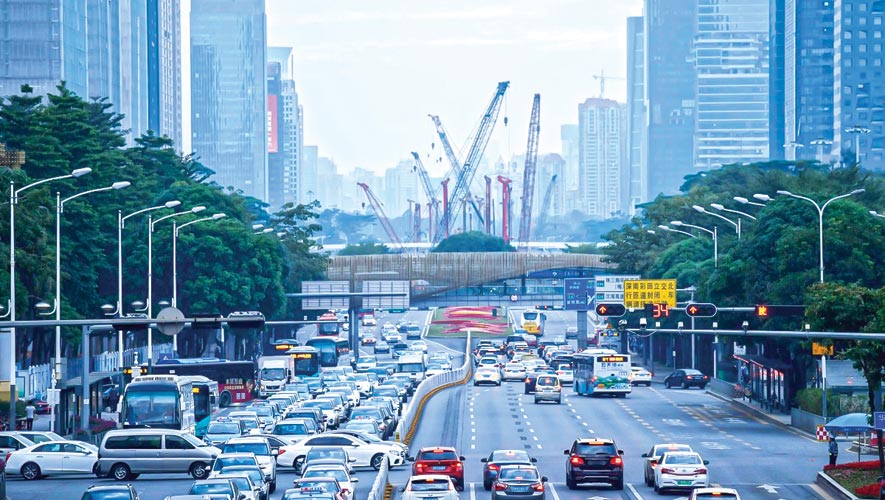The one-time small fishing village blazed the way for a ‘miraculous change’
For the latest Cambodian Business news, visit Khmer Times Business
On Aug 18, the official Chinese media published the full text of the guidelines issued by the Chinese Communist Party’s central committee and the State Council on making Shenzhen City a pioneering area of socialism with Chinese characteristics (henceforth refererred to as “guidelines”).
As early as July 24 this year, at the ninth meeting of the Central Comprehensively Deepening Reforms Commission, it was clear that China would support Shenzhen to achieve this.
As the most successful special economic zone in China, Shenzhen has always been the benchmark for the country’s reform and opening-up. In 2018, the gross development product (GDP) of Shenzhen City was 242,218 billion Yuan.
In yuan-based comparison, this was much higher than Hong Kong’s 22.1 billion yuan in the same period.
The new orientation given by the central government to the “first demonstration area of socialism with Chinese characteristics” clearly implies the development intention of the government at the strategic level.
ANBOUND’s chief researcher Chen Gong believes this is a strategic re-definition of the Shenzhen Special Economic Zone after entering a new era in history, and this represents a major transformation of Shenzhen.
Chen believes that the change of Shenzhen from a “special zone” to “socialist pioneering zone” is not merely a change of name, but a major transformation with substantial content, strategic depth, good background timing and regional characteristics.
Preferential policies
As is common in China, the interpretation of general policies will closely follow policy texts and explore its details such as strategic positioning, development goals, innovation space, preferential policies, major projects, and others.
The next step would be turning these into local development actions and seeking available fiscal, financial and policy resources to implement them.
These specific elements will also stimulate the domestic capital market and related parties will prepare a variety of investment growth narratives in order to create different investment hotspots.
In the guidelines, the Central Committee has given Shenzhen a series of development goals at varying levels.
Some of the macro development goals include promoting reform and opening-up to the rest of the world at a higher starting point with higher goals at a correlatively higher level.
This is also aimed to better implement the strategy of the Guangdong, Hong Kong and Macau Greater Bay Area (henceforth Greater Bay), enriching the new practice of “one country, two systems” and creating urban examples of socialist power and modernisation.
The goals encompass strategic positionings of Shenzhen’s future development direction, such as making Shenzhen a high ground of high-quality development, a model of urban rule of law, an example of urban civilization, a benchmark of people’s livelihoods and a pioneer of sustainable development.
In addition, there is also the three steps goal.
The first step is that by 2025, Shenzhen’s economic strength and quality of development will rank among the top cities in the world.
International, innovative city
It will be recognised as a modern, international and innovative city.
The second step is that by 2035, Shenzhen will become a creative and entrepreneurial capital with global influence, being an urban example of China as a modernised socialist power.
The third step is that, by the middle of this century, Shenzhen will become a global benchmark city with competitiveness, innovation and influence.
These are the macro goals of Shenzhen’s future development and what Shenzhen should aim to be.
At a specific level, the macro goal of Shenzhen’s transformation has been broken down into many sub-targets that include the following categories.
1. Innovation and development. Shenzhen will be developed into a comprehensive national science centre.
As a consequence of this, the Chinese authorities will support Shenzhen in 5G, artificial intelligence, internet science and technology, life information and biomedical laboratory, as well as other major innovation carriers to explore the establishment of an international science and technology information centre and an academy of medical sciences with a new system.
Basic and applied research will also be strengthened.
Shenzhen will become a centre for intellectual property, as well as scientific and technological achievements.
Its various units, institutions and enterprises will be supported to set up scientific research institutions abroad.
All these will make Shenzhen a free-trade pilot area of a high standard and quality.
2. Financial development. Shenzhen’s second-board market listing, as well as its system for restructuring refinancing as well as mergers and acquisitions will be improved.
The reform of its registration system will also be promoted.
Innovative applications such as digital currency research and mobile payment in Shenzhen will be supported.
In addition, interoperability with Hong Kong and Macau’s financial markets, as well as mutual recognition of financial fund products will be promoted.
Shenzhen will play a role in the promotion of the internationalisation of the yuan and the exploration of innovative cross-border financial supervision.
Furthermore, Shenzhen will carry out comprehensive reform of regional state-owned assets and state-owned enterprises, being a pilot in the deepening reform of foreign exchange management.
3. Talent and mechanism reform. Shenzhen will be supported to implement a more open and convenient overseas talent introduction, and entry-exit management system.
This will allow international talented people who have obtained permanent residence qualifications to establish science and technology enterprises in Shenzhen and act as legal representatives of scientific research institutions.
4. Development of the Greater Bay Area. The deepening of reform and the opening-up of the Qianhai Shenzhen-Hong Kong Modern Service Industry Cooperation Zone will accelerate the construction of the Shenzhen-Hong Kong Science and Technology Innovation Cooperation Zone and explore a collaborative development model.
This will promote the co-development of Shenzhen-Dongguan-Huizhou, thereby encouraging the integration and interaction between the east and the west banks of the Pearl River estuary, in addition to promoting innovation and the improvement of the cooperation zone’s management system and mechanism.
Shenzhen will also be supported to build a large data centre in the Greater Bay Area, as well as constructing an international cruise port.
5. Rule of law. Under the leadership of the party, the people’s orderly political participation will be expanded to make full use of the legislative power of Shenzhen and, under the premise of observing the basic principles of the Constitution, laws and administrative regulations, Shenzhen will be allowed to make reforms and innovations in practice.
Shenzhen will also be able to make changes to laws, administrative regulations and local regulations in accordance with the proper authorisation.
This will improve the system of major administrative decision-making procedures.
6. People’s livelihoods. Shenzhen will be supported in leading the way in reforming the education system and popularise quality high school education.
The autonomy of higher education institutions will be implemented.
In addition, a modern vocational education system will be established.
Social forces will be encouraged to develop high-level medical institutions and facilitate the development of Hong Kong and Australian-funded medical institutions.
There will also be a relaxation of restrictions on overseas doctors practising on the mainland, gradually realising the equalisation of basic public services for the resident population.
Hong Kong and Macau residents working and living in Shenzhen will also be able to enjoy “citizen treatment”.
7. Green development. This is to ensure the party and government have the same responsibility, with one post and two responsibilities in ecological and environmental protection.
A green development-oriented evaluation and assessment system will be established for ecological civilisation.
Improvement of ecological and environmental protection policies such as environmental credit evaluation, mandatory disclosure of information, and the environmental public interest litigation system will be conducted.
Following that, the authorities will also carry out trials to control the total discharge of pollutants into key sea areas.
They will continue to implement the dual control actions on total energy consumption and energy intensity.
The multiple development goals given by the central government will become specific tasks that Shenzhen will implement in the future.
Frankly speaking, to achieve the above development goals, Shenzhen faces great challenges and there is great demand in supporting resources as well as for breakthroughs in reform.
Even if all the conditions are met, it does not guarantee that Shenzhen will achieve all its goals and fully satisfy the central government.
From the national perspective, we believe that it is more important to grasp the core intent of the central policy and the key concepts behind the policy. According to the observation and analysis of ANBOUND’s consulting research team, the “new era” is a key concept in the central government’s “guidelines” that is supporting Shenzhen’s transformational development – in fact it appears as many as nine times in the “guidelines” put forward.
Chinese characteristics
Since the 19th CPC National Congress, socialism with Chinese characteristics has entered into a new era and thereby all developments should also follow suit and enter a new era.
Otherwise, the Shenzhen Special Economic Zone would be the same as it was for the past 40 years. But, in doing so, however, the new concept loses its foundation. Therefore, the “new era” has in essence created the foundation for the “new concept”. It is because of the “new era” that the necessity of developing a “socialist pilot demonstration zone” exists.
In fact, the central government’s specific requirements and directions for the first demonstration zone are not entirely innovative content – and this is seen in the requirements for economic, legal, social, culture, education, health care, high technology, talent, environment etc.
These elements are the most basic content for a city’s construction and development in the future.
The requirements are also to ensure the continuation of the Shenzhen Special Economic Zone’s development model in the past.
The essence of the central government’s new policy is “new era”.
Therefore, the key to grasp the policy is to understand that special zones in the new era are socialist pilot demonstration zones.
It should not be a major problem for the construction of the city to continue practices that were effective in the past.
In a word, in the new socialist era, the concept of “pilot demonstration zone” will reassure the market and many others.
Final analysis conclusion:
In the new era of socialism with Chinese characteristics, Shenzhen’s mission is to become an example of China’s construction of a powerful modern socialist city and, at the same time, provide a successful practice different from the Hong Kong model in the development of the Greater Bay Area.
Chen Gong founded the Anbound Think Tank in 1993. He is now ANBOUND chief researcher. Chen Gong is one of China’s renowned experts in information analysis. Most of Chen Gong’s outstanding academic research activities are in economic information analysis, particularly in the area of public policy.




